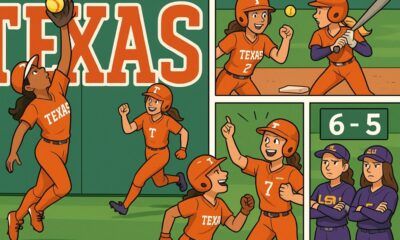
Daniel de la Hoz/Moment via Getty Images
Lina Begdache, Binghamton University, State University of New York
Feeling drained and lethargic is common: A 2022 national survey found that 13.5% of U.S. adults said they felt “very tired” or “exhausted” most days or every day over a three-month period.
Women ages 18 to 44 had the highest rate of fatigue – just over 20%.
Being tired is linked to something deeper than just overwork or a sign of the times. I’m a registered dietitian and nutritional neuroscientist. My research, along with the work of others in the field, shows that your diet and lifestyle choices may contribute to your struggles. These two factors are closely interconnected and could be the key to understanding what’s holding you back.
In particular, not getting enough of three essential nutrients – vitamin D, vitamin B12 and omega-3 fatty acids – is linked to low energy levels.
Vitamin D
More than 40% of adult Americans are deficient in vitamin D. Low levels are linked to fatigue, bone pain, muscle weakness, mood disorders and cognitive decline.
Foods high in vitamin D include fatty fish like salmon, sardines, freshwater rainbow trout, fortified dairy products and egg yolks. Among the sources for vegetarians and vegans are fortified plant-based milks and cereals and some kinds of mushrooms.
The U.S. government’s recommended daily amount of vitamin D is 400 international units, or IU, for infants up to 12 months, 600 IU for people ages 1 to 70 and 800 IU for people over 70. Just over 5 ounces (150 grams) of sockeye salmon fillet has about 800 IU of vitamin D. If you are low in a vitamin, your doctor may prescribe you a higher dose than the recommended daily amount to elevate your blood levels to normal.

Vitamin B12
About 20% of Americans have inadequate vitamin B12 levels, which can impair energy production and lead to anemia, resulting in fatigue.
Low levels of B12 are notably higher in older people, pregnant and lactating women, people with gastrointestinal disorders like inflammatory bowel disease, those who take certain medications like proton-pump inhibitors, and people with alcohol use disorder.
Because vitamin B12 is primarily found in meat, fish, dairy and eggs, vegetarians and vegans should consider taking a vitamin B12 supplement. The recommended daily amount for anyone ages 4 and older is 2.4 micrograms, about what’s found in 3 ounces of tuna or Atlantic salmon. Pregnant and breastfeeding women require slightly more.
Taking B12 supplements can be as effective as getting the vitamin from food – and taking the supplement with food may enhance its absorption.
That said, here’s a note on supplements in general: While they can be beneficial, they shouldn’t replace whole foods.
Not only are supplements less strictly regulated by the Food and Drug Administration compared to prescription and over-the-counter drugs, making their potency uncertain, but real food also provides a complex array of nutrients that work in a synergistic way. Many supplements on the market boast multiple servings of vegetables, but nothing beats the actual food.

fcafotodigital/E+ via Getty Images
Omega-3 fatty acids
About 87% of adults ages 40 to 59, and about 80% of those 60 and older, don’t get enough omega-3 fatty acids to meet dietary recommendations. Neither do many pregnant women.
Omega-3 fatty acids are crucial for brain health, and a deficiency can lead to higher anxiety and depression levels and impaired cognitive function. Taken together, these deficiencies can add to fatigue.
The best sources of omega-3 fatty acids are fatty fish, but if you’re strictly vegan, flaxseeds, chia seeds and walnuts can be great alternatives. However, it’s worth noting the omega-3s in fish are absorbed better in the body than plant sources – and that determines how efficiently the body can use the omega-3.
Also, whole flaxseed has a tough outer shell, which makes it more difficult to digest and absorb its nutrients. But ground flaxseed has been broken down, making the omega-3s and other nutrients more available for absorption.
The role of alcohol
Although alcohol may provide a sense of relaxation in the moment, it actually contributes to fatigue after the buzz wears off. Alcohol is a toxin; it forces your body to prioritize its metabolism over that of nutrients, which means the body reduces the use of carbohydrates and fat for energy.
Alcohol also reduces the absorption of B vitamins, which consequently affects energy production. The bottom line: If you drink alcohol, ultimately you will feel tired.
Lifestyle factors
Diet isn’t everything. Sunlight, exercise, better sleep and stress management are all critical factors for reducing fatigue.
Your body can make vitamin D from sunlight, and you don’t need a lot. A few minutes up to a half hour of sun exposure can help most people get what they need. The amount of time can vary depending on where you live, how much clothing you wear and what time of year you get the exposure. You’ll reach your vitamin D daily quota much faster on a sunny day during the summer than a cloudy day in winter.
And it may sound counterintuitive, but the more you exercise, the more energy you will produce; working out doesn’t drain you. Instead, it boosts energy, along with mood, by improving blood flow and helping to release endorphins, which are hormones produced by the body to relieve pain or stress.
Without exercise, the human body becomes less efficient at producing energy, which leads to lethargy. Coupled with erratic blood sugar levels – often caused by diets high in refined sugars and low in nutrients – these energy dips and spikes can leave you feeling irritable and drained.
Aim for at least 150 minutes of moderate exercise each week through activities like brisk walking, cycling, swimming and strength training.
Poor sleep makes things even worse. Not getting enough rest disrupts the body’s natural recovery processes and will leave you with diminished energy and focus.
So you should try to get seven to nine hours of quality sleep each night. For some people this is not easy; creating a calming bedtime routine helps, and limiting screen time is key.
Avoid phones, computers and other screens for at least 30 to 60 minutes before bed. The blue light emitted from screens can interfere with your body’s production of melatonin, a hormone that helps regulate sleep. Conversely, activities like reading, meditation or gentle stretching help signal to your body that it’s time to sleep.
In short, there are things you can do about your fatigue. Smart choices help optimize mood, energy levels and overall health, and reduce the surges of sluggishness you feel throughout the day.
Make no mistake: Your diet and lifestyle can make all the difference between being alert or wiped out.![]()
Lina Begdache, Associate Professor of Health and Wellness Studies, Binghamton University, State University of New York
This article is republished from The Conversation under a Creative Commons license. Read the original article.

























































